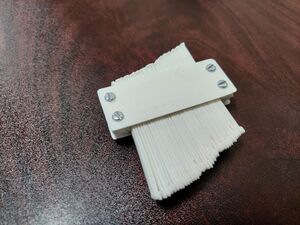Shape Gauge / Contour Gauge[edit | edit source]
This is a tool that consists of a series of steel and plastic plates that are held very close to each other and secured inside the frame. The pins or plastic will extend and retract according to the contour that we place against. The net result of this action is that the contour gauge pins now have acquired the exact shape of the contour, which can then be transferred to another piece of material. These devices are also referred to as shape duplicators. The use of contour profile gauges is common in architecture and woodworking activity. They can also be used, for instance, by flooring installers when there is a need to perform a complex cut to the edge of a ceramic or porcelain tile, or to a sheet of linoleum so that it will mate against a complex surface. Hobbyists and craft workers also use these types of gauges. Profile gauges are also used widely in metalworking and woodworking. In architectural conservation, they are used to document the profiles of decorative moldings. In the archaeological illustration, they are typically used to record the profile of pots, and are thus named pottery gauges; but in ceramics, a pottery gauge is a template used in making pots.
My science hardware[edit | edit source]
I have designed my profile gauge strips and its housing on open source designing software OpenSCAD. I have 3D printed all the components on a 3D printer using PLA material and my assembly weighs 88 grams. Hence the total cost of my assembly is $13.
Gallery[edit | edit source]


